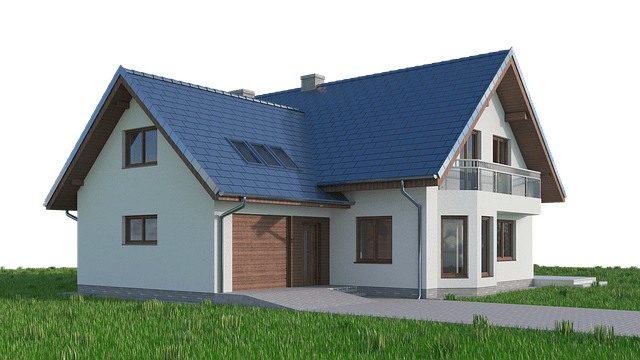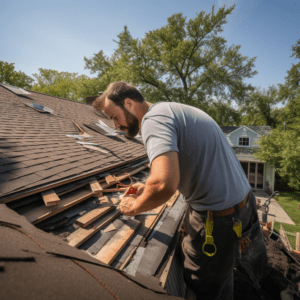Commercial roof replacement is a crucial undertaking for businesses seeking to ensure the longevity and functionality of their roofing systems. Recognizing the signs that necessitate replacement, evaluating pertinent factors, and selecting appropriate materials are essential steps towards an effective replacement process. Additionally, hiring competent contractors and considering cost implications contribute to a successful outcome. This article explores the importance of commercial roof replacement, highlights key indicators of deterioration, discusses various roofing materials and contractors, outlines the process itself, and emphasizes the benefits associated with this investment.
Key Takeaways
- Commercial roof replacement is important for ensuring the longevity and functionality of roofing systems.
- It helps protect the building structure from damages caused by weather elements and prevents leaks, water damage, mold growth, and structural instability.
- Commercial roof replacement offers an opportunity to upgrade to more energy-efficient roofing materials, reducing heating and cooling costs and the carbon footprint.
- It also extends the lifespan of the building, enhances energy efficiency, improves indoor air quality, and increases property value.
Importance of Commercial Roof Replacement
The significance of commercial roof replacement lies in the maintenance and protection of the building structure from potential damages caused by weather elements, leading to increased longevity and durability. Commercial roofs are exposed to various environmental factors such as rain, snow, hail, wind, and extreme temperature fluctuations. Over time, these elements can cause wear and tear on the roof surface, leading to leaks, water damage, mold growth, and structural instability.
Regular maintenance and timely replacement of commercial roofs are essential for ensuring the integrity of the entire building structure. By replacing worn-out or damaged roofs with new ones, businesses can prevent further deterioration that could compromise the safety of occupants and result in costly repairs or even complete roof failure.
Moreover, commercial roof replacement offers an opportunity to upgrade to more advanced roofing materials that provide enhanced energy efficiency. Energy-efficient roofing systems can help reduce heating and cooling costs by minimizing heat transfer through the roof surface. This not only benefits businesses financially but also contributes to reducing their carbon footprint.
Signs That Your Commercial Roof Needs Replacement
Indications of the necessity for a new roof in the commercial setting are often characterized by extensive wear and tear, frequent leaks, and compromised structural integrity. Commercial roofs endure constant exposure to various elements such as extreme weather conditions, UV radiation, and pollutants. Over time, these factors can cause significant damage to the roof’s surface, leading to deterioration and potential failure.
One of the most obvious signs that a commercial roof needs replacement is extensive wear and tear. This includes visible cracks, blisters, or bubbles on the roof’s surface. Additionally, if there are numerous patches or repairs throughout the roof’s lifespan, it may indicate that the underlying structure is compromised.
Frequent leaks are another key indicator of a failing commercial roof. If water stains appear on ceilings or walls inside the building after rainfall or snowmelt events, it suggests that water is penetrating through gaps or damaged areas in the roofing system.
Compromised structural integrity is an essential factor to consider when evaluating whether a commercial roof requires replacement. Signs of structural issues include sagging sections of the roof deck, warped trusses or beams supporting the roof structure, or visible signs of rot and decay.
Factors to Consider Before Replacing Your Commercial Roof
Factors to consider before replacing a commercial roof include the age of the existing roof, its condition, and the potential impact on building occupants. The age of the roof is an important factor because older roofs may be more prone to leaks, deterioration, and other issues that can compromise their structural integrity. It is generally recommended to replace a commercial roof that is over 20 years old, as it may no longer provide adequate protection against weather elements.
The condition of the existing roof should also be assessed before making a decision about replacement. Signs of damage such as cracks, blisters, or missing shingles indicate that the roof is in poor condition and may require immediate attention. Additionally, if there have been frequent repairs or ongoing maintenance issues with the current roof, it may be more cost-effective in the long run to invest in a new roof rather than continuing to patch up problems.
Another crucial consideration is how the replacement will impact building occupants. Roof replacement projects can cause disruptions to daily operations and potentially expose occupants to noise, dust, and other inconveniences. Therefore, it is essential to plan for these disruptions and communicate with tenants or employees about any necessary precautions or temporary relocation arrangements.
Different Types of Roofing Materials for Commercial Roof Replacement
Different types of roofing materials offer various advantages and disadvantages for commercial buildings in need of a roof replacement. The choice of roofing material is crucial as it affects the longevity, durability, energy efficiency, and overall performance of the roof. One common option is asphalt shingles, which are cost-effective and easy to install. However, they have a shorter lifespan compared to other materials and may not be suitable for areas with extreme weather conditions. Metal roofs provide superior durability and can withstand harsh weather elements such as strong winds or heavy snowfall. They also have a long lifespan and require minimal maintenance. However, metal roofs tend to be more expensive upfront compared to other options. Another popular choice is single-ply membranes like EPDM or TPO, which offer excellent resistance against UV rays and can withstand temperature fluctuations well. These membranes are lightweight and easy to install but may require more frequent maintenance compared to other materials. Lastly, built-up roofs (BUR) consist of multiple layers of asphalt alternated with ply sheets or felts, providing exceptional durability and waterproofing capabilities. However, BUR systems can be costly due to the labor-intensive installation process. Ultimately, the selection of roofing material should consider factors such as budgetary constraints, climate conditions, building structure requirements, and desired lifespan to ensure optimal performance for commercial buildings undergoing roof replacement projects
Hiring the Right Contractor for Commercial Roof Replacement
When hiring a contractor for the replacement of a commercial building’s roof, it is important to consider their experience, qualifications, and reputation in order to ensure a successful project. Experience is crucial because commercial roof replacement requires specialized skills and knowledge that can only be gained through years of practical work in the field. A contractor with extensive experience will be familiar with the various types of roofing systems used in commercial buildings and will have encountered different challenges that may arise during the replacement process.
In addition to experience, qualifications also play a significant role in selecting the right contractor. A qualified contractor should possess proper licensing and certifications that demonstrate their expertise and adherence to industry standards. These qualifications provide reassurance that they are capable of performing the job to satisfactory levels.
Furthermore, reputation is an essential factor when considering potential contractors. It is advisable to seek recommendations from other business owners or professionals who have previously worked with them. Online reviews or testimonials can also offer valuable insights into a contractor’s reliability, professionalism, and quality of work.
Overall, choosing the right contractor for commercial roof replacement involves careful consideration of their experience, qualifications, and reputation. By making informed decisions based on these factors, businesses can ensure that their roofing project is completed successfully and meets all necessary requirements.
The Process of Commercial Roof Replacement
The process of replacing a commercial building’s roof involves several steps, including inspection, removal of the existing roofing materials, installation of new materials, and final quality checks. Firstly, an inspection is conducted to assess the condition of the existing roof and identify any underlying issues. This helps determine the scope of work required for the replacement. Once the inspection is complete and a plan has been developed, the next step involves removing the old roofing materials. This may include stripping off shingles, tiles, or metal sheets and disposing them properly according to waste management regulations.
After removal, the installation of new roofing materials begins. Depending on the type of roof chosen for replacement – such as asphalt shingles, metal panels or EPDM membranes – specialized techniques are employed to ensure proper attachment and sealant application. It is crucial that all layers are installed correctly to prevent leaks and ensure longevity.
Finally, once installation is complete, a series of quality checks are performed to verify that everything has been done according to industry standards and manufacturer specifications. These checks may involve inspecting seams and joints for tightness or conducting water tests to detect any potential leaks.
In conclusion, commercial roof replacement requires careful planning and execution. By following these steps – inspection, removal of existing materials, installation of new materials, and final quality checks – property owners can ensure a successful roof replacement project that will protect their building from weather elements for years to come.
(186 words)
Cost Considerations for Commercial Roof Replacement
This discussion will focus on two key points related to commercial roof replacement: budgeting for replacement and long-term cost savings. Budgeting for replacement involves considering the initial investment required for a new roof, as well as any additional costs such as labor and materials. Long-term cost savings, on the other hand, involve analyzing the potential energy efficiency and maintenance benefits of different roofing options in order to minimize future expenses.
Budgeting for Replacement
Determining the financial allocation necessary for a commercial roof replacement project is crucial in order to ensure a well-planned and cost-effective budget. Budgeting for a commercial roof replacement involves several factors that need careful consideration. First, one must assess the size and complexity of the roof, as larger roofs or those with intricate designs may require more materials and labor. Additionally, the type of roofing material selected will impact the overall cost, with options ranging from traditional asphalt shingles to more durable and expensive options like metal or slate. Other factors to consider include any necessary repairs or structural modifications, permits and inspections required by local authorities, disposal costs for removing old roofing materials, and potential additional expenses such as safety equipment or warranties. By thoroughly evaluating all these elements, businesses can develop an accurate budget that ensures a successful commercial roof replacement project within their financial means.
Long-Term Cost Savings
Long-term cost savings can be achieved by considering factors such as roofing materials, repairs, permits, disposal costs, safety equipment, and warranties when budgeting for a commercial roof replacement project. Selecting high-quality roofing materials that are durable and energy-efficient can reduce long-term maintenance and repair costs. It is important to factor in the potential need for future repairs or upgrades when choosing the roofing system. Obtaining the necessary permits beforehand can prevent costly delays or fines during the project. Proper disposal of old roofing materials should also be accounted for to avoid additional expenses. Investing in safety equipment and training for workers can minimize accidents and potential liability costs. Lastly, reviewing warranty options and selecting comprehensive coverage can provide financial protection against unforeseen issues that may arise after installation. By considering these various factors, businesses can make informed decisions that lead to long-term cost savings in their commercial roof replacement projects.
Benefits of Investing in Commercial Roof Replacement
Investing in commercial roof replacement can offer several benefits for building owners and operators. One of the key advantages is increased energy efficiency, as a new roof can help to improve insulation and reduce heat loss or gain. This can result in significant cost savings over the long term, as less energy will be required to maintain a comfortable indoor temperature. Additionally, a new roof can enhance the property value by improving its overall appearance and functionality, making it more appealing to potential buyers or tenants.
Increased Energy Efficiency
Enhancing the energy efficiency of commercial roof replacements has become a significant focus in contemporary construction practices. Improving energy efficiency in commercial buildings not only helps reduce greenhouse gas emissions but also leads to cost savings for building owners and occupants. Various strategies can be employed during commercial roof replacement projects to enhance energy efficiency. These include selecting roofing materials with high thermal resistance, such as cool roofs or green roofs, to minimize heat absorption and reduce cooling loads. Additionally, proper insulation installation and sealing of air leaks are crucial for preventing thermal bridging and improving overall energy performance. Incorporating renewable energy technologies like solar panels on the new roof can further contribute to reducing energy consumption and dependence on non-renewable sources. Overall, investing in energy-efficient commercial roof replacements can have long-term benefits by lowering operational costs and promoting sustainable practices in the construction industry.
Long-Term Cost Savings
One important aspect to consider when improving energy efficiency in buildings is the potential for significant cost savings over time. Implementing measures to enhance energy efficiency can lead to substantial long-term financial benefits. By reducing energy consumption, building owners can lower their utility bills and operating expenses. The initial investment required to improve energy efficiency may seem high, but the long-term savings outweigh these costs. Energy-efficient upgrades such as insulation, efficient lighting systems, and high-performance windows can result in reduced heating, cooling, and lighting expenses. Additionally, optimizing HVAC systems and implementing smart controls can further reduce energy consumption and operational costs. It is crucial for building owners to consider the long-term cost savings associated with energy-efficient improvements and make informed decisions that align with their financial goals.
Enhanced Property Value
The replacement of a commercial roof can have a significant impact on the overall value of a property. A well-maintained and aesthetically pleasing roof not only enhances the visual appeal of a building but also contributes to its market value. Potential buyers or tenants often consider the condition of the roof when evaluating a property, as it serves as protection against weather elements and impacts energy efficiency.
A new commercial roof installation can attract potential investors or lessees who are willing to pay a premium for properties with updated roofs that require minimal maintenance in the foreseeable future. Moreover, an enhanced property value resulting from a new roof can provide owners with an advantage in competitive real estate markets.
Property owners should consider undertaking timely commercial roof replacements to ensure their assets continue to appreciate in value while benefiting from improved protection and energy efficiency features.




